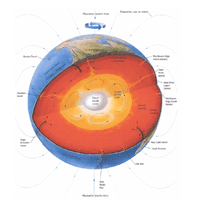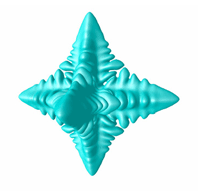KTH / KCSE / Research / Departments / Material science
Material science
Materials science, if defined in terms of length scales, spans
the five decades from nanometers to hundreds of micrometers. While traditional
materials engineering deals with continuum models on the large scale,
the effective properties are determined by features on the small scale
such as dislocations, grains, precipitations, and even molecules and
atoms. Thus, materials design is about manipulating small scale phenomena
by proper processing e.g., chemical and thermal,
to obtain favorable large-scale properties. Quantum-mechanical simulations
play an important role in materials science at the nano-end of the length
scale, for instance in order to understand
dislocations, magnetism, crystal structure, surface structure, and
catalytic behavior.
Sample projects
Simulation of iron structure in the Earth's core
The Earth's core consists mainly of iron and is a sphere with a
radius of about 3500 km. The outer part of the core is liquid and the
inner
part is solid. Properties of iron at the inner core conditions are
of ultimate importance for understanding how the Earth functions. These
properties, in turn, critically depend on the atomic structure of the
iron phase which is stable at these conditions. In a recent paper large
scale calculations performed by a group at the department of Materials
Science and Engineering predict that the stable iron has bcc structure,
i.e. the atoms of iron are positioned in the corners of cube surrounding
the atom in the cube's center. This is an unexpected result, since it
has
been believed for about 40 years that iron in the inner core is
stable in the hexagonal close packed structure. The amount of thermal
energy and temperature, at which the iron inner core remains solid, critically
depends on the structure of the iron phase.
Simulation of structural and phase changes
The simulation of microstructure formation in materials is studied
in a collaboration between the department of Materials Science and Engineering and the department of Mechanics. A common microstructural
process in solidification is the growth of a dendritic crystal in an
undercooled melt, as shown in the figure. The complicated shape develops
due to inherent instabilities in the evolution of the phase boundary,
and is infuenced by the anisotropy of the forming crystalline phase. The
simulation was done by the phase field method, which treats the interface
as a smooth but steep transition.
Engineering and the department of Mechanics. A common microstructural
process in solidification is the growth of a dendritic crystal in an
undercooled melt, as shown in the figure. The complicated shape develops
due to inherent instabilities in the evolution of the phase boundary,
and is infuenced by the anisotropy of the forming crystalline phase. The
simulation was done by the phase field method, which treats the interface
as a smooth but steep transition.
|








